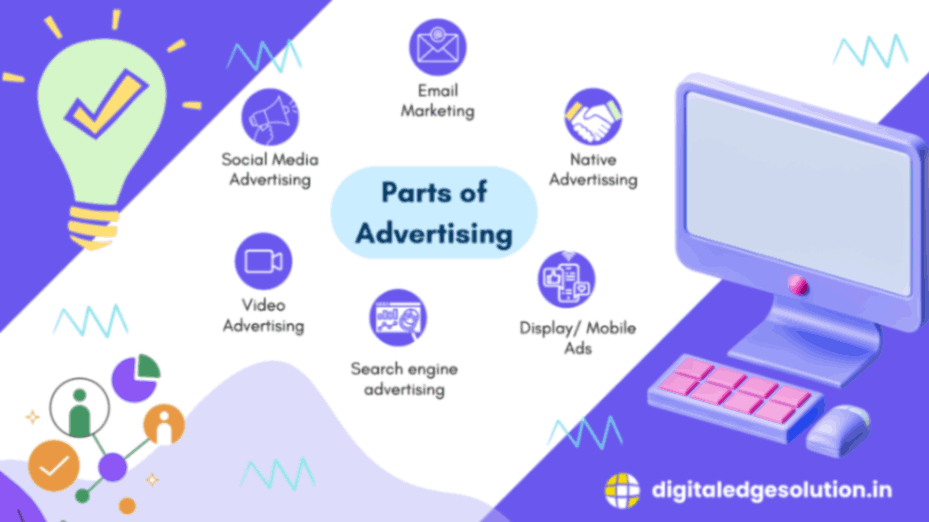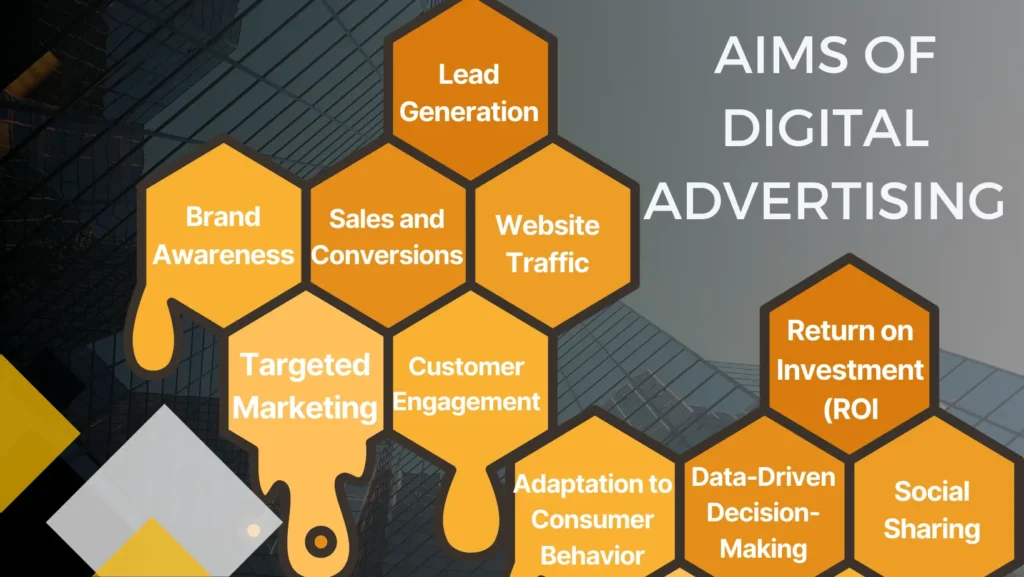What is Digital Advertising
Digital advertising is a dynamic field that requires adaptability and continuous optimization. Use these tips as your foundation, stay curious, and always be willing to refine your approach for sustained success in the ever-evolving digital landscape.
Welcome to your comprehensive guide on mastering the art of digital advertising. From defining your strategy to implementing effective campaigns, these tips will serve as your go-to resource for navigating the dynamic world of online promotion.

Understand your Audience
Know your audience inside and out. Develop detailed buyer personas to tailor your ads to resonate with their needs, preferences, and behaviors.
Target your Goals
Begin your expedition with clarity. Clearly define your advertising goals; whether it’s brand visibility, lead generation, or sales conversion, having a precise destination guides your entire campaign.
Choose the Right Platform
Select digital platforms based on where your audience spends their time. Options include social media (Facebook, Instagram, Twitter), search engines (Google, Bing), and display networks.
Craft Compelling Ad Creatives
Develop attention-grabbing visuals and copy. Ensure your message is clear, concise, and aligned with your brand. Test different creatives to understand what resonates best.
Utilize Targeting and Segmentation
Leverage platform targeting options to reach specific demographics, interests, and behaviors. Segment your audience to deliver more personalized messages.
Implement Effective Keywords
For search engine advertising, choose relevant keywords that align with your business. Regularly update and refine your keyword list based on performance.
Optimize Landing pages
Ensure that the landing pages your ads direct users to are relevant, user-friendly, and optimized for conversions. A seamless user experience is crucial.
Set a Realistic Budget
Establish a budget aligned with your goals. Monitor and adjust spending based on the performance of your ads to maximize ROI.
Monitor and Analyze Metrics
Track key performance indicators (KPIs) such as click-through rates (CTR), conversion rates, and return on ad spend (ROAS). Use analytics tools to gain insights into user behavior.
A/B Testing
Continuously experiment with A/B testing to refine your strategies. Test different ad variations, audiences, and placements to identify what works best.
Re-marketing Strategies
Implement re-marketing to re-engage users who have interacted with your brand but haven’t converted—tailor ads based on their previous actions.
Stay Informed on Trends
Digital advertising is dynamic. Stay informed about industry trends, algorithm changes, and new features on advertising platforms to adapt your strategies accordingly.
Compliance and Transparency
Adhere to advertising regulations and ensure transparency in your messaging. Build trust with your audience by providing accurate information.
Evaluate and Adjust
Regularly review your campaign performance and adjust your strategy based on data. Identify successful elements to replicate and areas for improvement.
Need/Importance of Digital Advertising

Online Presence and Visibility
In today’s digital age, consumers spend a significant amount of time online. Digital advertising allows businesses to establish a strong online presence, ensuring that their products or services are visible to a broad audience.
Global Reach
Digital advertising enables businesses to reach a global audience, breaking down geographical barriers. This is especially important for companies aiming to expand their market beyond local boundaries.
Targeted Marketing
Digital advertising provides advanced targeting options. Businesses can tailor their ads to specific demographics, interests, behaviors, and even geographical locations. This precision helps in reaching the right audience with the right message.
Cost-Effectiveness
Compared to traditional advertising channels, digital advertising often offers more cost-effective solutions. Businesses can allocate budgets strategically, optimizing spending based on performance metrics.
Real-Time Analytics
Digital advertising platforms provide real-time analytics and insights into campaign performance. This data allows businesses to measure the effectiveness of their campaigns, understand audience behavior, and make informed decisions for optimization.
Interactivity and Engagement
Digital ads can be interactive, engaging users in various ways. Whether through clickable elements, social media interactions, or multimedia content, digital advertising creates a more engaging experience for the audience.
Mobile Access
With the widespread use of smartphones, digital advertising allows businesses to connect with consumers on their mobile devices. This is essential as mobile usage continues to rise, making it a critical platform for reaching potential customers.
Flexibility and Adaptability
Digital advertising offers flexibility in terms of ad formats, platforms, and campaign duration. Businesses can quickly adapt their strategies based on market trends, consumer behavior, and business goals.
Competitive Edge
In a competitive market, having a strong digital presence is a key differentiator. Businesses that leverage digital advertising effectively can gain a competitive edge, staying top-of-mind for consumers in a crowded online space.
Measurable Results
Unlike some traditional forms of advertising, digital advertising provides measurable results. Businesses can track key performance indicators (KPIs), such as clicks, conversions, and impressions, allowing for data-driven decision-making.
Personalization
Digital advertising facilitates personalized marketing efforts. Tailoring messages to specific audience segments based on their preferences and behaviors enhances the overall customer experience, increasing the likelihood of conversion.
Major Parts Of Advertising

The major parts of digital advertising include:
- Search Engine Advertising (SEA): Ads on search engine result pages
- Social Media Advertising: Ads on platforms like Facebook, Instagram, etc.
- Display Advertising: Visual ads on websites and apps.
- Video Advertising: Short promotional videos on various platforms.
- Email Marketing: Promotional messages sent to a targeted email list.
- Content Marketing: Creating valuable content for engagement.
- Affiliate Marketing: Partnering for commission-based promotions.
- Native Advertising: Ads seamlessly integrated into platform content.
- Programmatic Advertising: Automated real-time ad buying.
- Mobile Advertising: Ads targeting users on mobile devices.
- Remarketing/Retargeting: Showing ads to users who previously interacted.
- Analytics and Data Analysis: Measurement and analysis of campaign performance.
Aims of Digital Advertising
The aims of digital advertising are to achieve specific objectives such as increasing brand awareness, driving website traffic, generating leads, boosting sales, enhancing customer engagement, and supporting overall business goals through strategic online promotion and audience targeting.

1. Brand Awareness
Businesses aim to increase visibility and make more people aware of their brand through digital advertising.
2. Lead Generation
Digital advertising is used to capture potential customers’ information and generate leads for further engagement.
3. Sales and Conversions
The primary goal is often to drive sales and conversions, turning potential customers into actual buyers.
4. Website Traffic
Businesses seek to attract more visitors to their websites through digital advertising.
5. Customer Engagement
Engaging with customers through online channels to build relationships and foster brand loyalty is a key aim.
6. Targeted Marketing
Precision targeting based on demographics, interests, and behaviors helps reach specific audiences effectively.
7. Return on Investment (ROI)
Optimization of advertising strategies to achieve a favorable return on the investment made in digital advertising.
8. Adaptation to Consumer Behavior
Aligning digital marketing strategies with how consumers use digital platforms to stay relevant.
9. Data-Driven Decision-Making
Using data and analytics to make informed decisions and refine advertising strategies.
10. Social Sharing
Encouraging users to share content and recommendations through social media.
Conclusion
As you embark on your digital advertising expedition armed with this guide, remember that success isn’t just about reaching your goals but embracing the journey of continuous learning and adaptation. Let every click, every impression, and every interaction be a step toward unparalleled success in the ever-evolving world of digital advertising. May your campaigns sail smoothly, capturing the attention and hearts of your audience. Happy advertising!